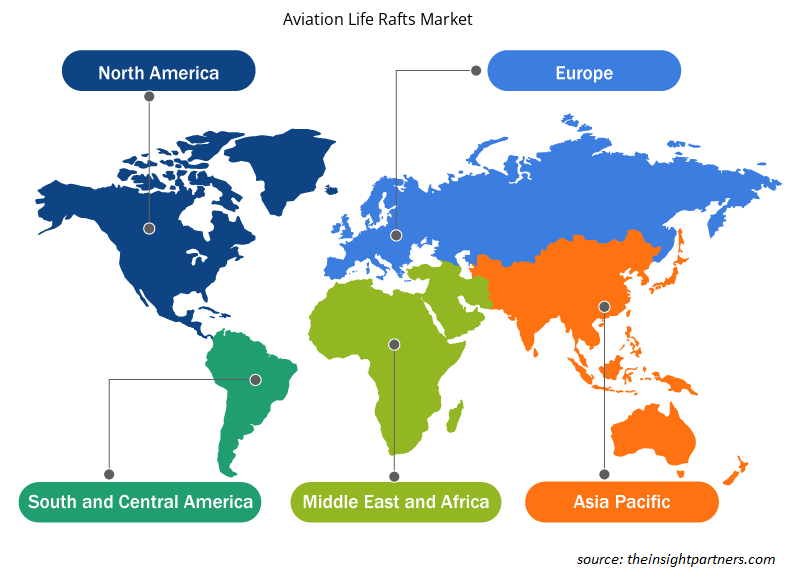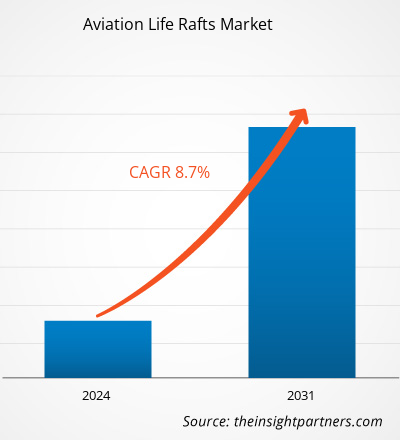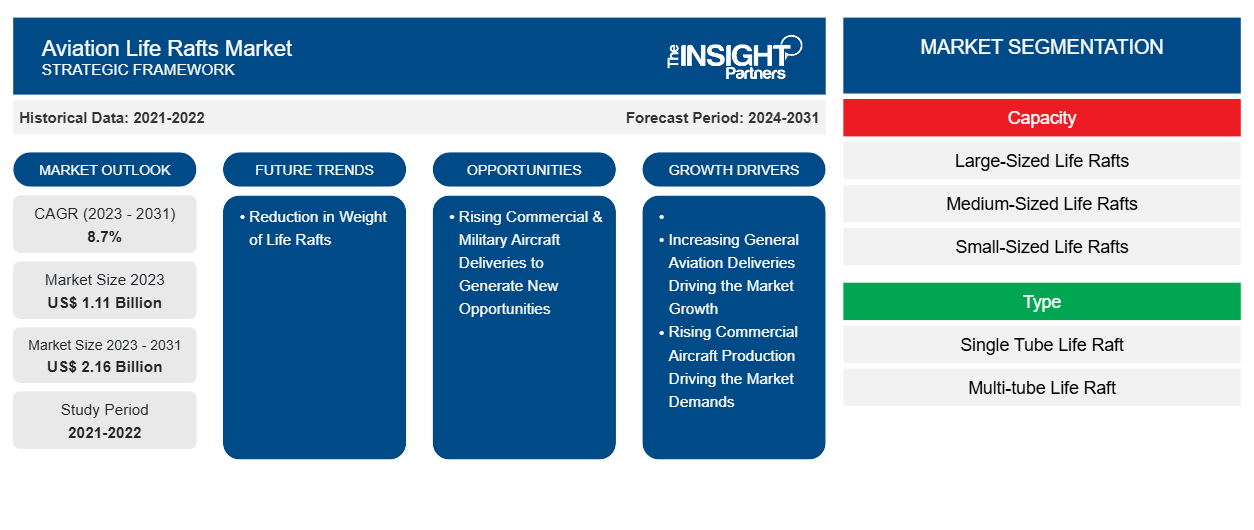Der Markt für Rettungsflöße für die Luftfahrt soll von 1,11 Milliarden US-Dollar im Jahr 2023 auf 2,16 Milliarden US-Dollar im Jahr 2031 anwachsen. Der Markt soll in den Jahren 2023–2031 eine durchschnittliche jährliche Wachstumsrate von 8,7 % verzeichnen. Die Akteure auf dem Markt für Rettungsflöße für die Luftfahrt bieten ihre Produkte mit einer Lebensdauer von mehr als zehn Jahren an; die Lebensdauer der Rettungsflöße ist jedoch auf drei Jahre begrenzt. Die kürzere Lebensdauer ermöglicht es dem Endnutzer, alle drei Jahre neuere Rettungsflöße zu montieren, was dem Endnutzer zugutekommt, da ein reibungsloses Aufblasen und der weitere Betrieb des Floßes bei etwaigen Wasserlandungsunfällen gewährleistet ist.
Marktanalyse für Rettungsinseln für die Luftfahrt
Die wichtigsten Akteure auf dem Markt für Rettungsflöße für die Luftfahrt sind Lieferanten von Rettungsflößen, Hersteller von Rettungsflößen für die Luftfahrt und Endverbraucher. Die Nachfrage nach Rettungsflößen für die Luftfahrt ist aufgrund der wachsenden Flugzeugproduktion und staatlicher Investitionen hoch. Die zunehmenden F&E-Initiativen verschiedener Unternehmen ergänzen das Wachstum des globalen Luft- und Raumfahrtmarktes zusätzlich. Im Marktökosystem bieten Lieferanten von Rettungsflößen verschiedene Materialien für Rettungsflöße für die Luftfahrt an. Zu den Lieferanten von Rettungsflößen gehören Trellborg AB, ContiTech AG und viele mehr. Der Hersteller von Rettungsflößen bietet verschiedene Arten von Rettungsflößen an. Einige der auf dem Markt vertretenen Hersteller sind Collins Aerospace, Safran, Survitec Group Ltd. und viele mehr. Die Hersteller konzentrieren sich stark darauf, ihren Kundenstamm durch das Angebot innovativer Rettungsflöße für die Luftfahrt zu erweitern. Die Endverbraucher des Marktes für Rettungsflöße für die Luftfahrt beziehen diese Rettungsflöße direkt von den Herstellern. Zu den Endverbrauchern auf dem Markt gehören Flugzeughersteller, Streitkräfte und Flugzeugbetreiber der allgemeinen Luftfahrt.
Marktübersicht für Rettungsinseln für die Luftfahrt
Die Nachfrage nach Rettungsflößen für die Luftfahrt wird hauptsächlich durch einige der unten genannten Faktoren bestimmt:
- Zunehmende Auslieferungen in der Allgemeinen Luftfahrt treiben das Marktwachstum an
- Steigende Produktion von Verkehrsflugzeugen treibt die Marktnachfrage
- Kürzere Lebensdauer von Rettungsinseln in der Luftfahrt
Diese Faktoren treiben das Wachstum des Marktes für Rettungsinseln für die Luftfahrt in verschiedenen Regionen ständig voran. Zu den wichtigsten Endverbrauchern von Rettungsinseln für die Luftfahrt zählen OEMs für Verkehrs- und Militärflugzeuge, OEMs für allgemeine und Regionalflugzeuge sowie MRO-Anbieter für Flugzeuge.
Passen Sie diesen Bericht Ihren Anforderungen an
Sie erhalten kostenlose Anpassungen an jedem Bericht, einschließlich Teilen dieses Berichts oder einer Analyse auf Länderebene, eines Excel-Datenpakets sowie tolle Angebote und Rabatte für Start-ups und Universitäten.
-
Holen Sie sich die wichtigsten Markttrends aus diesem Bericht.Dieses KOSTENLOSE Beispiel umfasst eine Datenanalyse von Markttrends bis hin zu Schätzungen und Prognosen.
Treiber und Chancen auf dem Markt für Rettungsinseln für die Luftfahrt
Zunehmende Auslieferungen in der Allgemeinen Luftfahrt treiben das Marktwachstum an
Der Anstieg der Zahl der Auslieferungen von Flugzeugen der allgemeinen Luftfahrt wird wahrscheinlich das Wachstum des Marktes für Rettungsflöße in verschiedenen Regionen vorantreiben. Laut der General Aviation Manufacturers Association (GAMA) wurden im Jahr 2023 rund 3.050 Einheiten von Flugzeugen der allgemeinen Luftfahrt in verschiedene Regionen ausgeliefert. Die Auslieferungen für die allgemeine Luftfahrt verzeichneten im Jahr 2023 im Vergleich zu 2022 ein Wachstum von 9 %. Darüber hinaus gibt es in jedem der Flugzeuge der allgemeinen Luftfahrt mindestens zwei Rettungsflöße, die nach den FAA TSO-C70a-Normen zertifiziert sind. Andererseits verzeichneten die Auslieferungen von Flugzeugen mit Kolbenmotor im Jahr 2023 ein starkes Wachstum von 11,8 % (1.682 Auslieferungen); bei Geschäftsreiseflugzeugen stieg die Zahl der Auslieferungen, die sich im Jahr 2023 auf 730 Einheiten beliefen, im Vergleich zu 712 Einheiten im Jahr 2022. Solche Faktoren treiben das Wachstum des Marktes für Rettungsflöße in der Luftfahrt weltweit voran.
Steigende Auslieferungen von Zivil- und Militärflugzeugen schaffen neue Chancen
Die steigende Zahl der Auslieferungen von Verkehrsflugzeugen ist einer der Hauptfaktoren, die im Prognosezeitraum wahrscheinlich neue Chancen für Marktanbieter schaffen werden. Die erwarteten Auslieferungen von Verkehrsflugzeugen in den nächsten 20 Jahren werden in den kommenden Jahren wahrscheinlich neue Chancen für Anbieter von Rettungsinseln für die Luftfahrt schaffen. Laut mehreren Quellen aus der Luftfahrt werden bis 2042 voraussichtlich mehr als 40.000 neue Verkehrsflugzeuge ausgeliefert. Darüber hinaus ist die erwartete Beschaffung von Militärflugzeugen ein weiterer wichtiger Faktor, der den Herstellern von Rettungsinseln in den kommenden Jahren wahrscheinlich neue Chancen bieten wird. Dies wird auch durch die anhaltenden Konflikte zwischen mehreren Ländern wie Russland und der Ukraine, Israel und Palästina sowie Israel und dem Iran unterstützt, die bei verschiedenen Nationen das Bewusstsein geweckt haben, ihre jeweiligen militärischen Stärken zu erhöhen. Zu diesem Zweck haben verschiedene Länder mehrere Verträge mit Herstellern von Militärflugzeugen für verschiedene Flugzeugtypen abgeschlossen, darunter Kampfflugzeuge, Überwachungsflugzeuge, Frachtflugzeuge und Tankflugzeuge. Solche Faktoren haben auch den Einsatz von Rettungsinseln im Militärflugzeugsegment vorangetrieben.
Segmentierungsanalyse des Marktberichts für Rettungsinseln für die Luftfahrt
Wichtige Segmente, die zur Ableitung der Marktanalyse für Rettungsinseln für die Luftfahrt beigetragen haben, sind Kapazität, Typ, Anwendung und Geografie.
- Basierend auf der Kapazität wurde der Markt in große Rettungsflöße, mittelgroße Rettungsflöße und kleine Rettungsflöße segmentiert. Das Segment der großen Rettungsflöße hatte im Jahr 2023 einen größeren Marktanteil.
- Nach Typ wurde der Markt in Rettungsflöße mit einem Schlauch und Rettungsflöße mit mehreren Schlauchen segmentiert. Das Segment der Rettungsflöße mit mehreren Schlauchen hatte im Jahr 2023 den größten Marktanteil.
- In Bezug auf die Anwendung wurde der Markt in allgemeine Luftfahrt, Militär-/Verteidigungsluftfahrt und kommerzielle Luftfahrt segmentiert. Das Segment der allgemeinen Luftfahrt dominierte den Markt im Jahr 2023.
Marktanteilsanalyse für Rettungsinseln in der Luftfahrt nach geografischen Gesichtspunkten
Der geografische Umfang des Marktberichts für Rettungsinseln für die Luftfahrt ist hauptsächlich in fünf Regionen unterteilt: Nordamerika, Europa, Asien-Pazifik, Naher Osten und Afrika sowie Südamerika.
Nordamerika dominierte den Markt für Rettungsinseln im Jahr 2023, während die Region Asien-Pazifik im Prognosezeitraum wahrscheinlich ein deutliches Wachstum verzeichnen wird. Die Vereinigten Staaten hatten einen größeren Marktanteil auf dem nordamerikanischen Markt für Rettungsinseln. Dies ist hauptsächlich auf die Präsenz mehrerer Hersteller von Rettungsinseln im Land zurückzuführen, nämlich EAM Worldwide, Life Support International, Inc., Revere Survival Inc., AVI Aviation und Collins Aerospace, um nur einige zu nennen. Dies ist einer der Hauptgründe für das Wachstum der Rettungsinseln im Land. Darüber hinaus gehören die Militärausgaben des Landes zu den höchsten weltweit, was die Entwicklung der größten Militärflugzeugflotte unterstützt und somit den Markt in den USA ankurbelt. Darüber hinaus ist die Präsenz großer Hersteller von Flugzeugen der allgemeinen Luftfahrt wie Northrop Grumman und Raytheon Technologies, um nur einige zu nennen, was die Integration von Rettungsinseln und Evakuierungsschiebern in diese Flugzeuge erfordert.
Regionale Einblicke in den Markt für Rettungsinseln für die Luftfahrt
Die regionalen Trends und Faktoren, die den Markt für Rettungsinseln für die Luftfahrt im Prognosezeitraum beeinflussen, wurden von den Analysten von Insight Partners ausführlich erläutert. In diesem Abschnitt werden auch die Marktsegmente und die Geografie von Rettungsinseln für die Luftfahrt in Nordamerika, Europa, im asiatisch-pazifischen Raum, im Nahen Osten und Afrika sowie in Süd- und Mittelamerika erörtert.

- Erhalten Sie regionale Daten zum Markt für Rettungsinseln für die Luftfahrt
Umfang des Marktberichts über Rettungsinseln für die Luftfahrt
| Berichtsattribut | Details |
|---|---|
| Marktgröße im Jahr 2023 | 1,11 Milliarden US-Dollar |
| Marktgröße bis 2031 | 2,16 Milliarden US-Dollar |
| Globale CAGR (2023 - 2031) | 8,7 % |
| Historische Daten | 2021-2022 |
| Prognosezeitraum | 2024–2031 |
| Abgedeckte Segmente |
Nach Kapazität
|
| Abgedeckte Regionen und Länder |
Nordamerika
|
| Marktführer und wichtige Unternehmensprofile |
|
Dichte der Marktteilnehmer für Rettungsinseln für die Luftfahrt: Die Auswirkungen auf die Geschäftsdynamik verstehen
Der Markt für Rettungsinseln für die Luftfahrt wächst rasant, angetrieben durch die steigende Nachfrage der Endnutzer aufgrund von Faktoren wie sich entwickelnden Verbraucherpräferenzen, technologischen Fortschritten und einem größeren Bewusstsein für die Vorteile des Produkts. Mit steigender Nachfrage erweitern Unternehmen ihr Angebot, entwickeln Innovationen, um die Bedürfnisse der Verbraucher zu erfüllen, und nutzen neue Trends, was das Marktwachstum weiter ankurbelt.
Die Marktteilnehmerdichte bezieht sich auf die Verteilung von Firmen oder Unternehmen, die in einem bestimmten Markt oder einer bestimmten Branche tätig sind. Sie gibt an, wie viele Wettbewerber (Marktteilnehmer) in einem bestimmten Marktraum im Verhältnis zu seiner Größe oder seinem gesamten Marktwert präsent sind.
Die wichtigsten auf dem Markt für Rettungsinseln für die Luftfahrt tätigen Unternehmen sind:
- EAM Weltweit
- Life Support International, Inc.
- Revere Survival Inc.
- Safran-Gruppe
- Survitec Gruppe Limited
- AVI-Luftfahrt
Haftungsausschluss : Die oben aufgeführten Unternehmen sind nicht in einer bestimmten Reihenfolge aufgeführt.

- Überblick über die wichtigsten Akteure auf dem Markt für Rettungsinseln für die Luftfahrt
Neuigkeiten und aktuelle Entwicklungen zum Markt für Rettungsinseln für die Luftfahrt
Der Markt für Rettungsflöße für die Luftfahrt wird durch die Erhebung qualitativer und quantitativer Daten nach Primär- und Sekundärforschung bewertet, die wichtige Unternehmensveröffentlichungen, Verbandsdaten und Datenbanken umfasst. Im Folgenden finden Sie eine Liste der Entwicklungen auf dem Markt für Rettungsflöße für die Luftfahrt und deren Strategien:
- Im Juli 2023 brachte AVI Survival Products das neue umkehrbare Rettungsfloß für 6 Passagiere auf den Markt. Das Produkt ist mit einem manuell aktivierten, durch eine Kordel ausgelösten, selbstaufblasenden System ausgestattet, das bei Bedarf eine schnelle Reaktion gewährleistet. Das Aufblassystem besteht aus einer mit N2/CO2 gefüllten Verbundflasche, einem Druckmesser und einem Aufblasventil. Darüber hinaus verfügt das umkehrbare Rettungsfloß über ein Floßmesser mit versenkbarer Klinge, eine Rettungsleine, die den äußeren Umfang des Floßes umschließt, ein Verdeck, das nach dem Einsteigen aufgestellt werden kann, eine Wurfleine und einen Ring, die in einem feuerhemmenden Beutel verstaut sind, einen speziell entwickelten Treibanker/Floßkoffer, der gleichzeitig als Doppelzweck verwendet werden kann, strategisch positionierte Einstiegshilfen, eine Handpumpenbaugruppe und ein umfassendes Ausrüstungsset. (Quelle: FCAH Aerospace, Pressemitteilung/Unternehmenswebsite/Newsletter)
- Im März 2022 hat Survitec ein „kleineres und leichteres Einsitzer-Rettungsfloß“ (SSLR) vorgestellt, um Piloten militärischer Jets bei anspruchsvolleren Missionen oder bei Notausstiegen aus ihren Flugzeugen über Wasser besser auszurüsten. (Quelle: Comtek Advanced Structures Ltd, Pressemitteilung/Unternehmenswebsite/Newsletter)
Marktbericht zu Rettungsinseln für die Luftfahrt – Umfang und Ergebnisse
Der Bericht „Marktgröße und Prognose für Rettungsinseln für die Luftfahrt (2021–2031)“ bietet eine detaillierte Analyse des Marktes, die die folgenden Bereiche abdeckt:
- Marktgröße und Prognose auf globaler, regionaler und Länderebene für alle wichtigen Marktsegmente, die im Rahmen des Projekts abgedeckt sind
- Marktdynamik wie Treiber, Beschränkungen und wichtige Chancen
- Wichtige Zukunftstrends
- Detaillierte Porter's Five Forces Analyse
- Globale und regionale Marktanalyse mit wichtigen Markttrends, wichtigen Akteuren, Vorschriften und aktuellen Marktentwicklungen
- Branchenlandschaft und Wettbewerbsanalyse, einschließlich Marktkonzentration, Heatmap-Analyse, prominenten Akteuren und aktuellen Entwicklungen
- Detaillierte Firmenprofile mit SWOT-Analyse
- Historische Analyse (2 Jahre), Basisjahr, Prognose (7 Jahre) mit CAGR
- PEST- und SWOT-Analyse
- Marktgröße Wert/Volumen – Global, Regional, Land
- Branchen- und Wettbewerbslandschaft
- Excel-Datensatz
Aktuelle Berichte
Erfahrungsberichte
Grund zum Kauf
- Fundierte Entscheidungsfindung
- Marktdynamik verstehen
- Wettbewerbsanalyse
- Kundeneinblicke
- Marktprognosen
- Risikominimierung
- Strategische Planung
- Investitionsbegründung
- Identifizierung neuer Märkte
- Verbesserung von Marketingstrategien
- Steigerung der Betriebseffizienz
- Anpassung an regulatorische Trends























 Kostenlose Probe anfordern für - Markt für Rettungsinseln für die Luftfahrt
Kostenlose Probe anfordern für - Markt für Rettungsinseln für die Luftfahrt